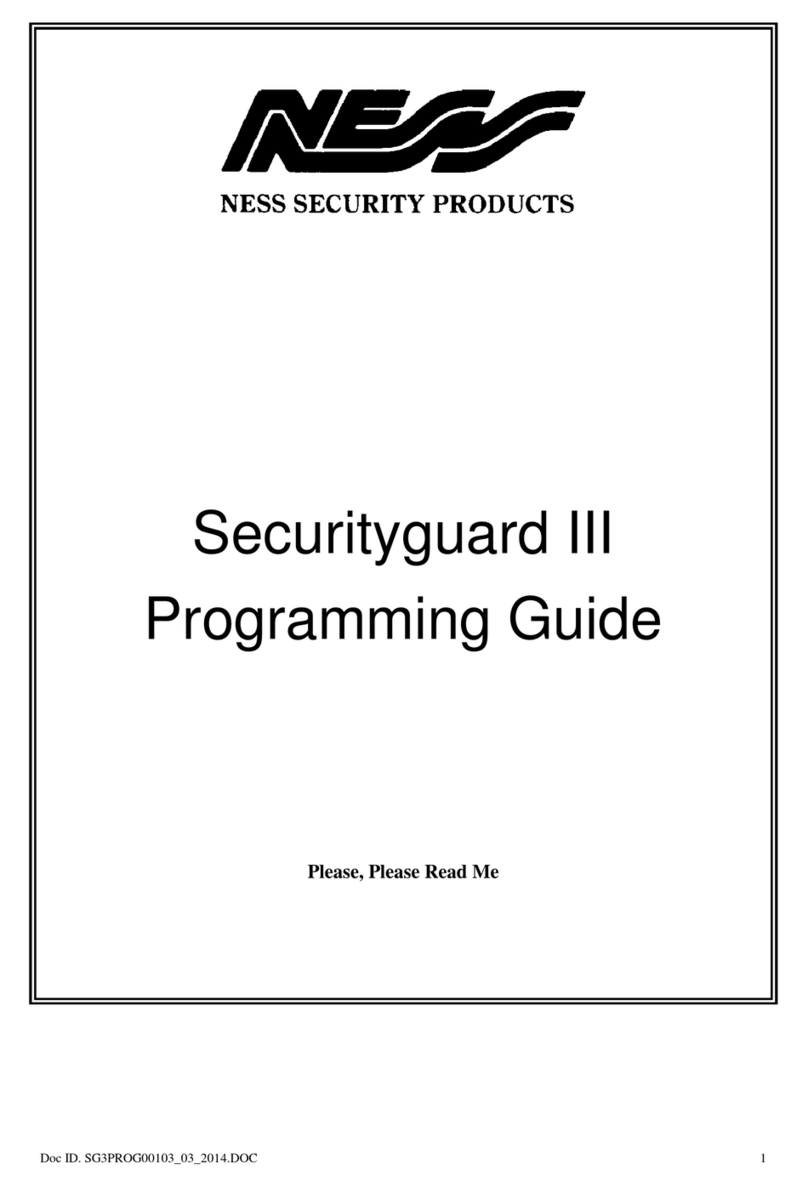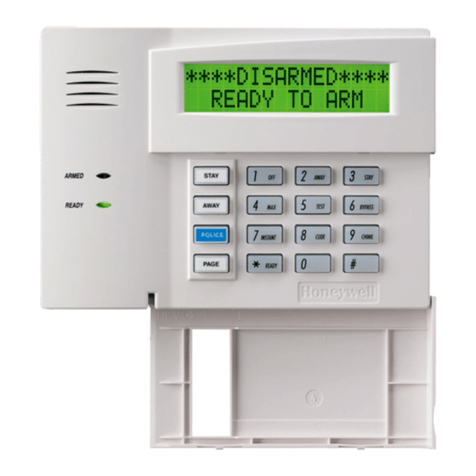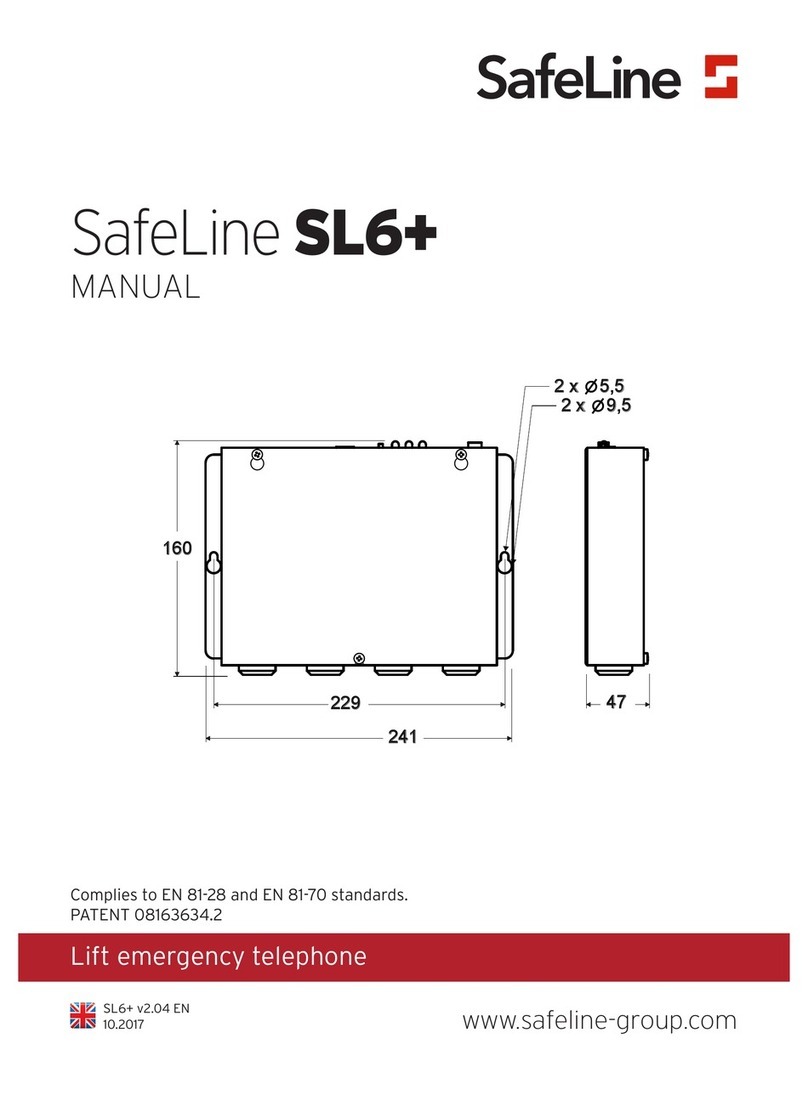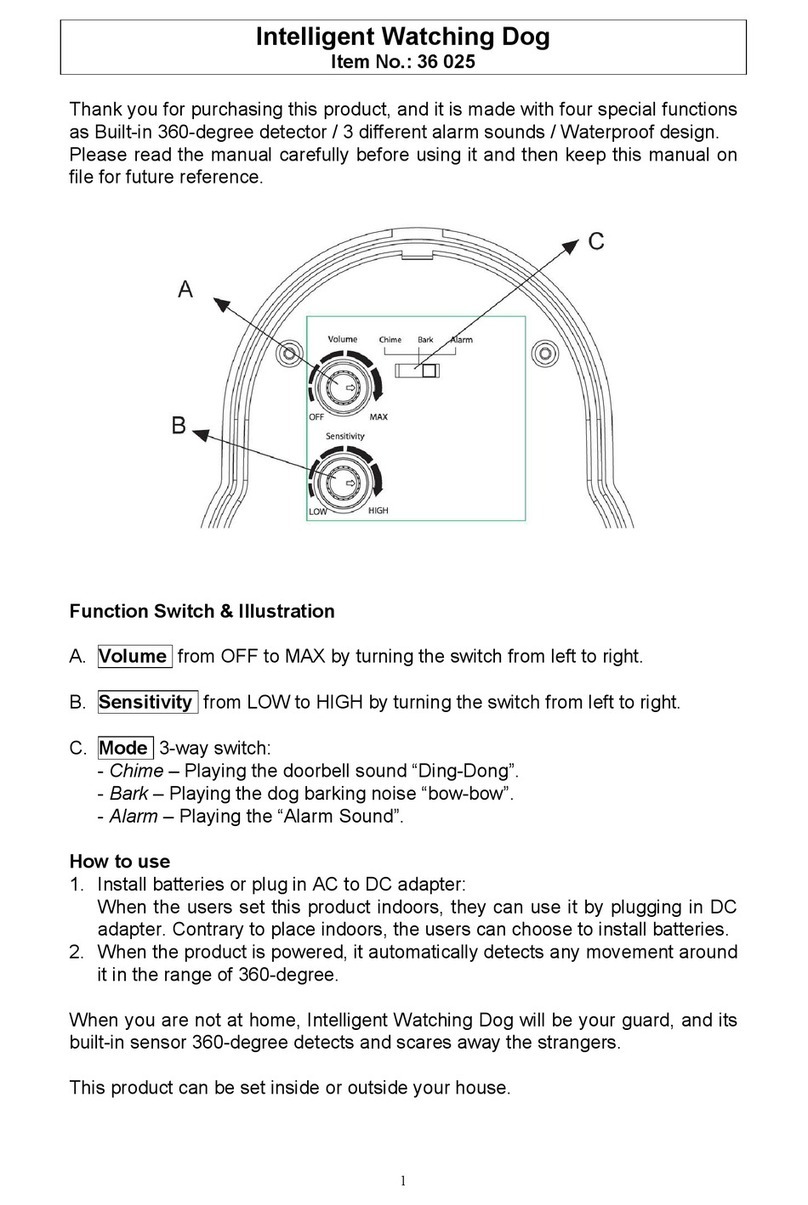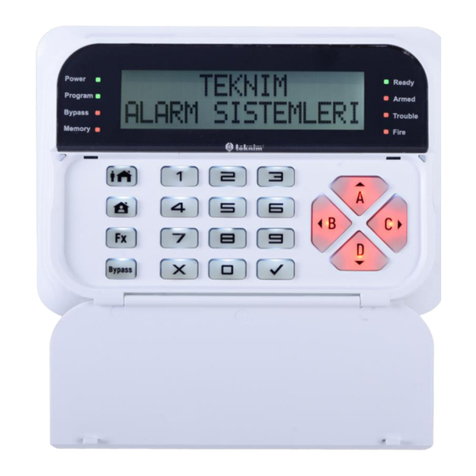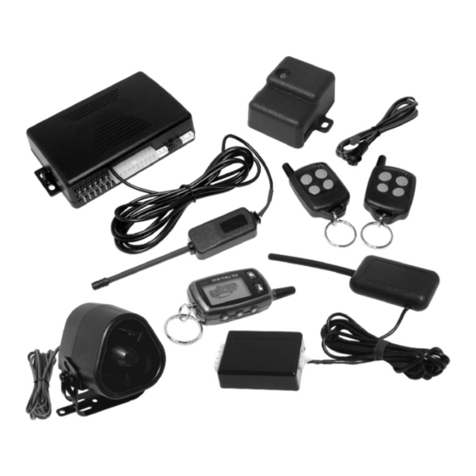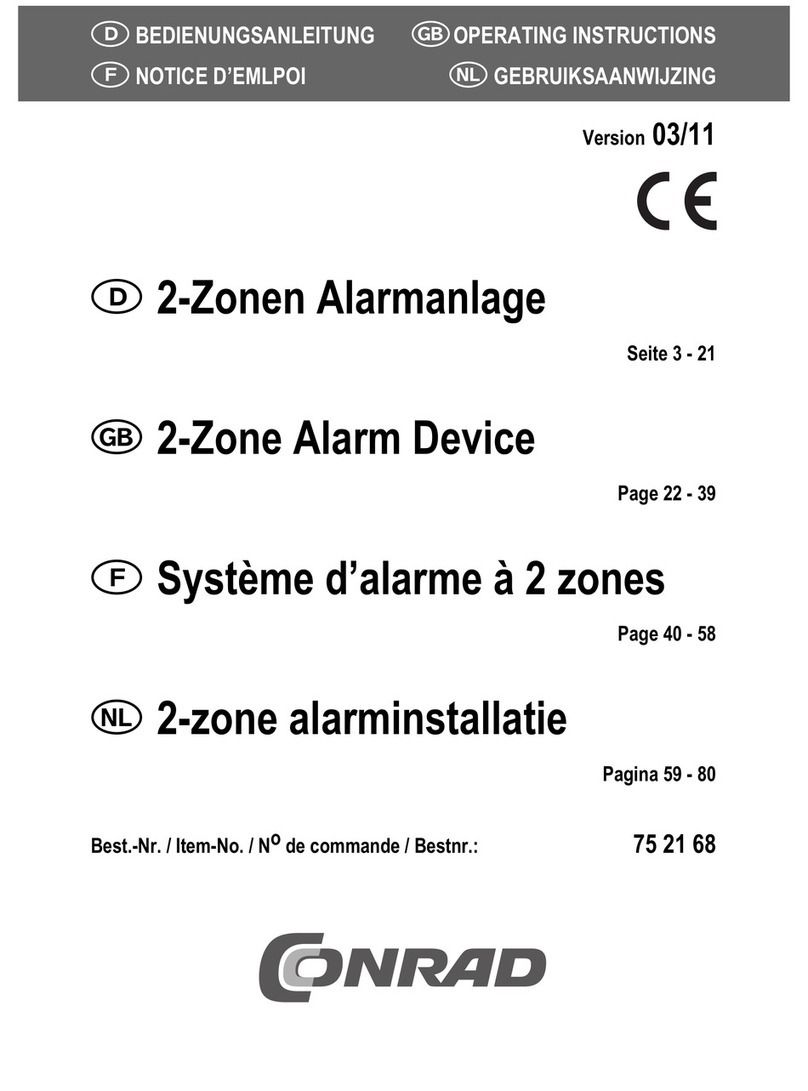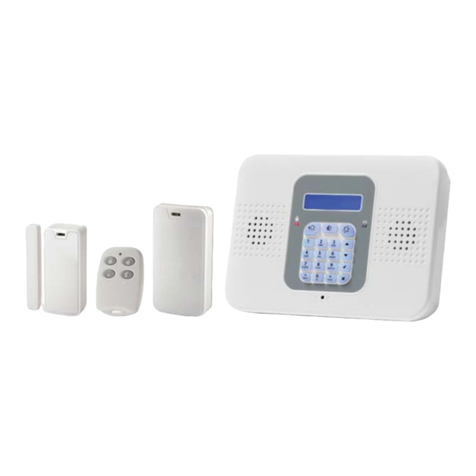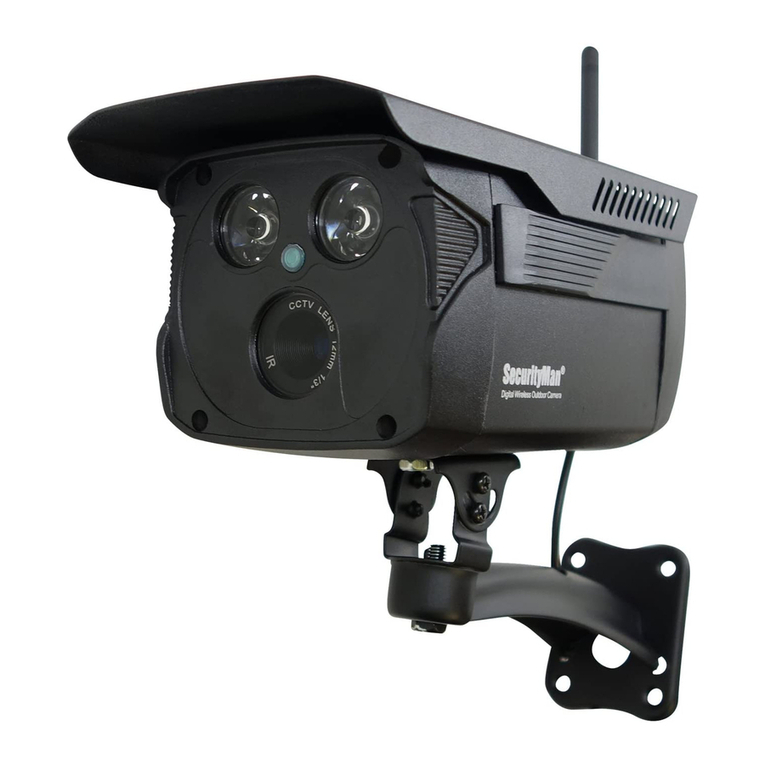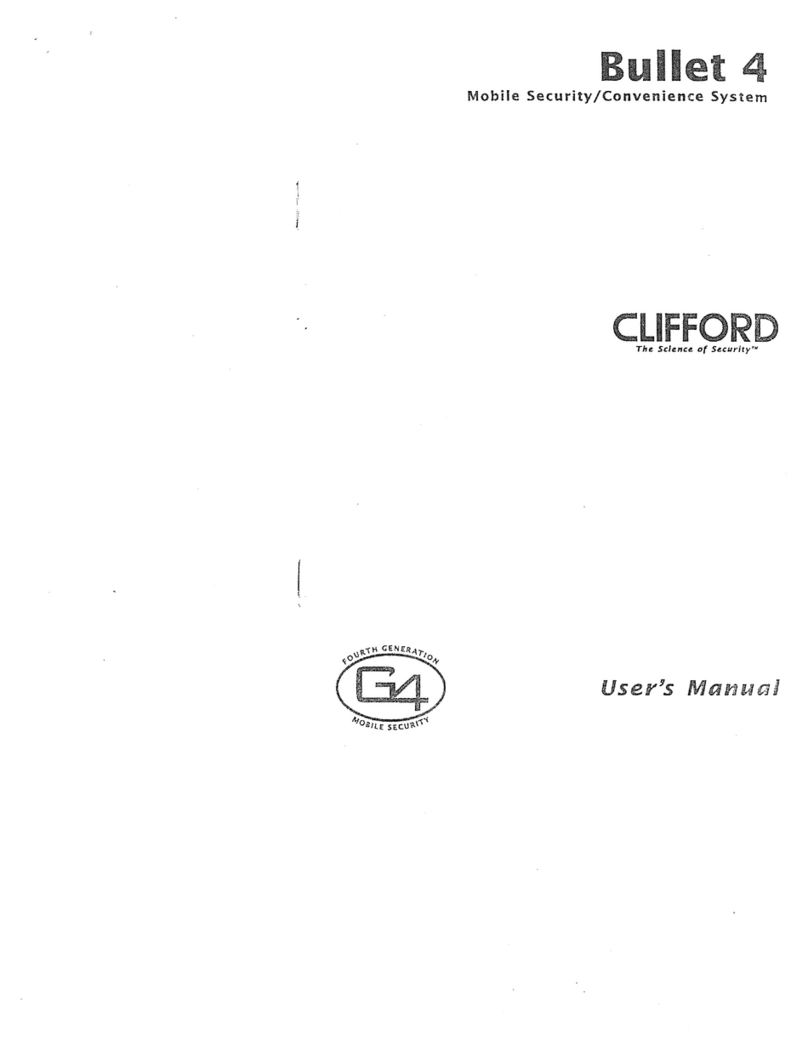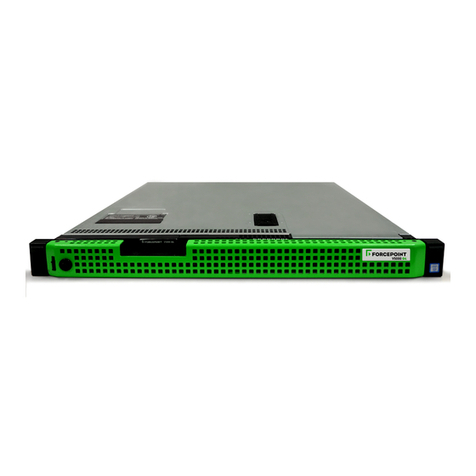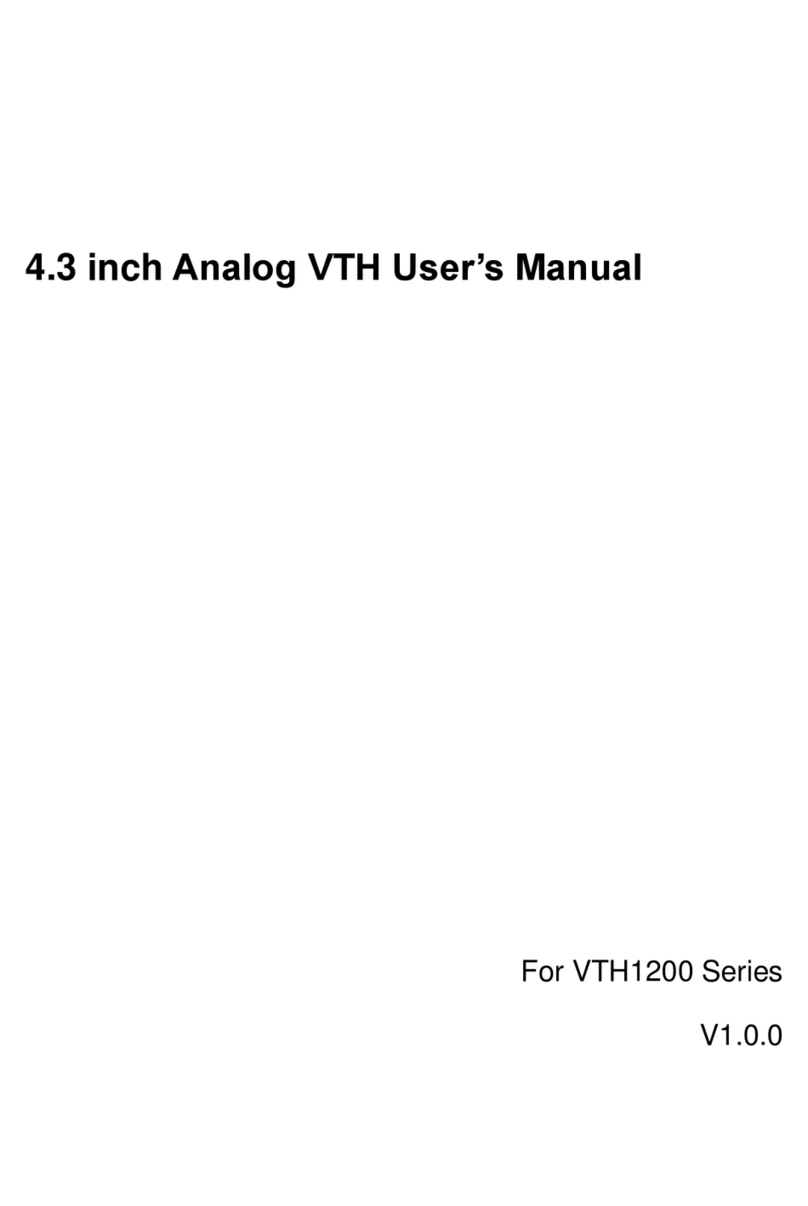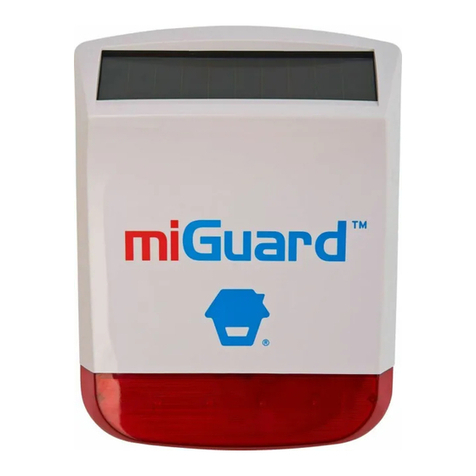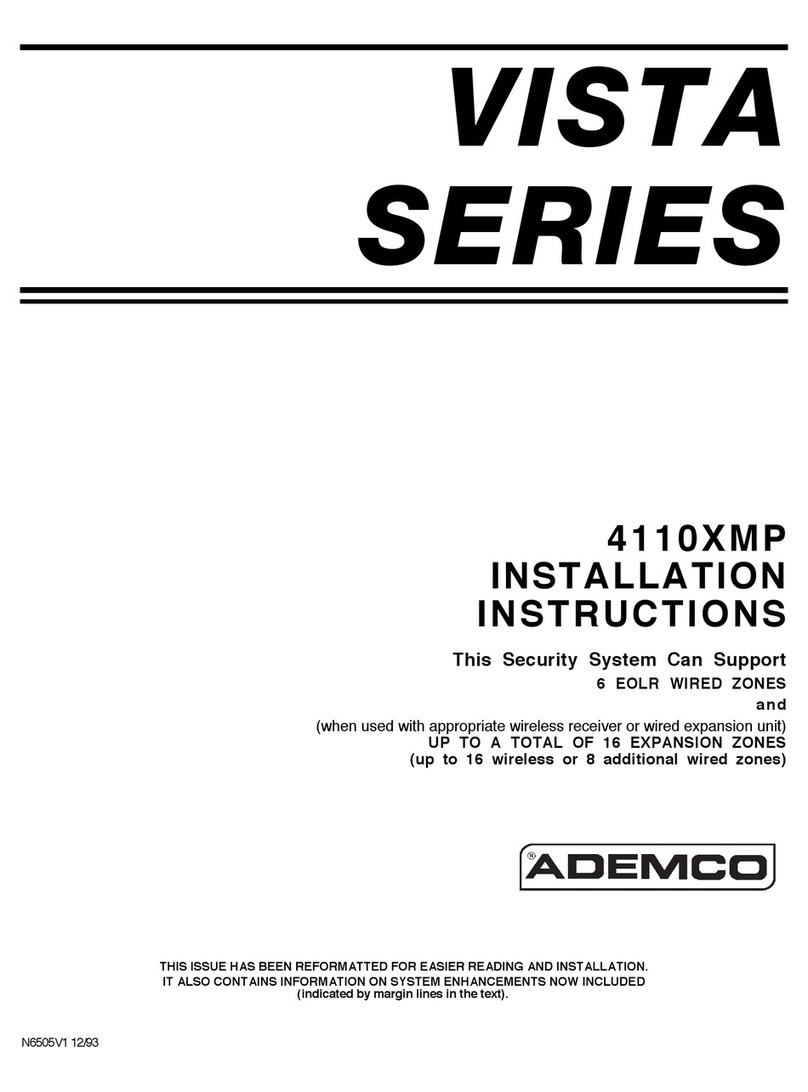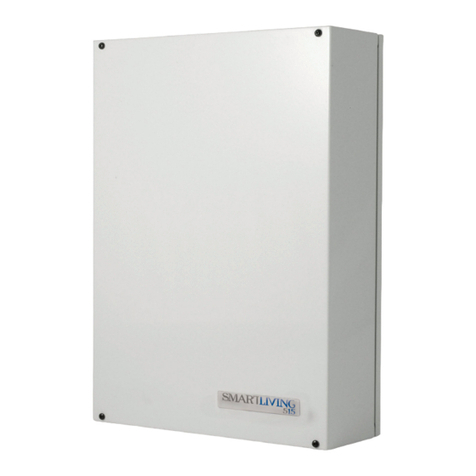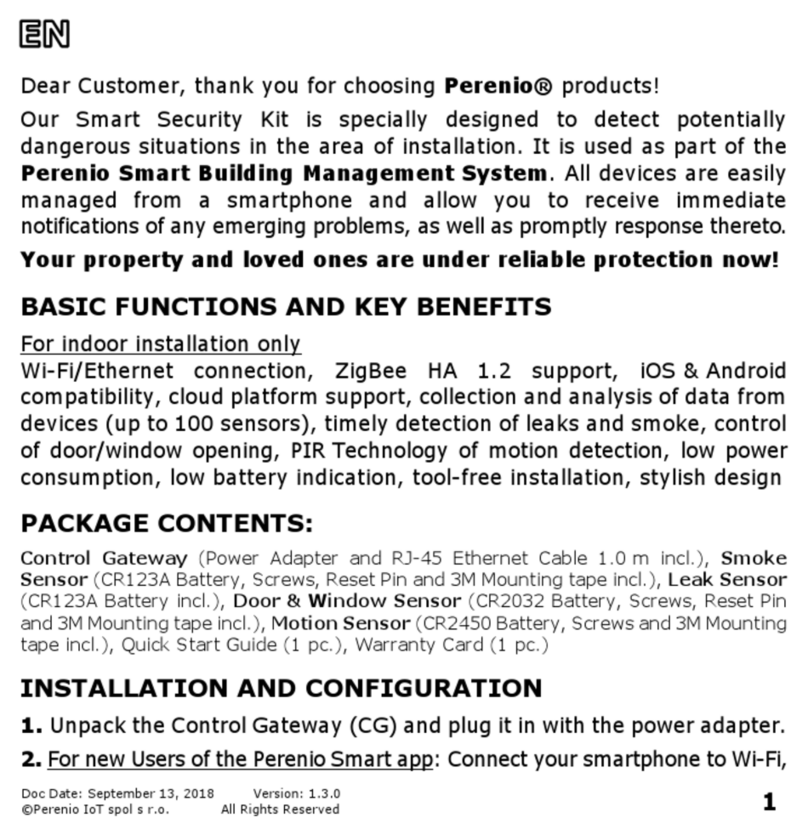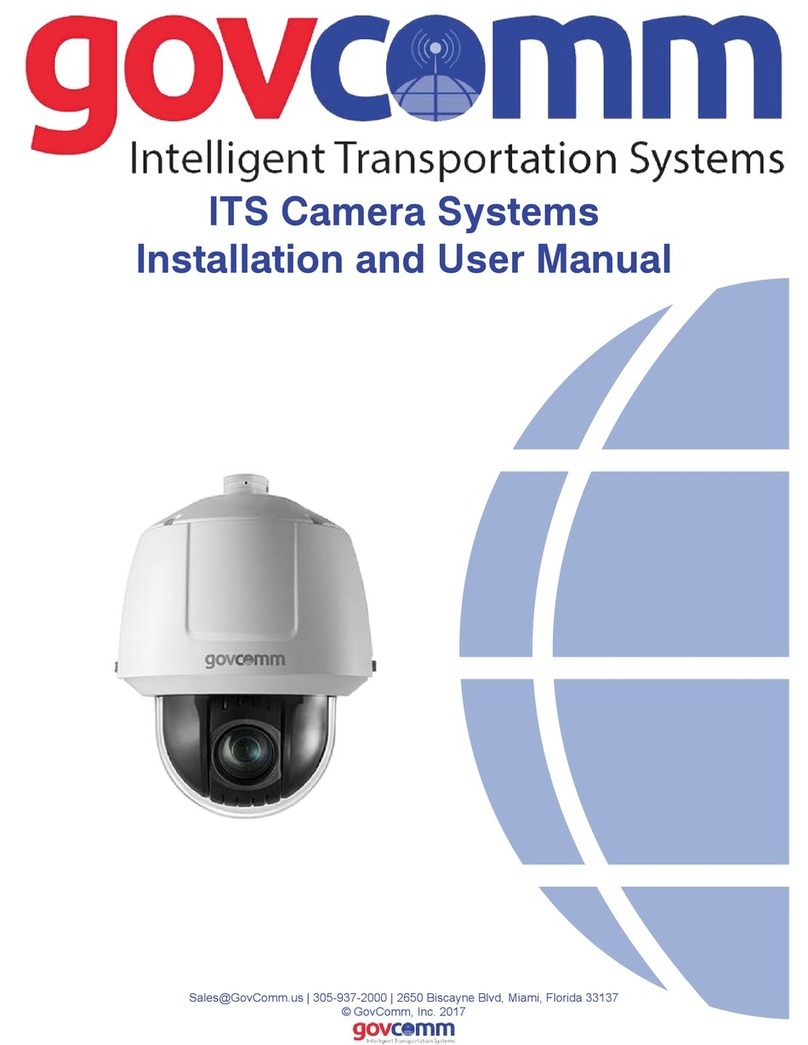Ness Security Products SecurityGuardII User manual

SECURITYGUARD
OWNERS MANUAL

Copyright by Ness Security Products
July 1998
To the best of our knowledge the information contained in this manual is correct at the time
of going to print. Ness Security Products or it’s suppliers reserve the right to make changes to the
features and specifications at any time and without prior notice in the course of product development.
WE CARE
Australia 131 241
New Zealand 0800 799

TABLE OF CONTENTS
4
5
6
7
8
9
10
11
12
13
14
15
16
17
18
19
20
21
22
Back
PAGE
3
Introduction
SecurityGuard Overview
Override switch
Glossary of Terminology
Symbols Used
Typical SecurityGuard Alarm System
Peripheral Devices
Radio Key
PIR Detector
Reed Switch
Operating your Alarm
Arm / Disarm
Emergency / Panic
Home
Low battery
SecurityGuard, battery charging
Changing Batteries
Radio Key
PIR Detector
Reed Switch
Miscellaneous Alarms and Warnings
Alarm
Tamper
Check Detectors
Fault Dialler
Detector Setup Options
Chime Detectors
(24 Hour Detectors)
Operating Mode summary
Maintenance
Troubleshooting
Summary of Operation and Displays

Thank you for purchasing your SecurityGuardII intruder alarm system. SecurityGuardII is a
revolutionary new radio based alarm system which has been built to the highest quality standards possible
and complies with the Australian Standard for Intruder Alarm systems AS2201, United Kingdom Standard
BS4737 & BS6799 and Canada C22.2 CSAN0205-M-1983
SecurityGuardII has been designed specifically to keep your family, yourself and your valuables under constant
guard and give you peace of mind for their safety. SecurityGuardII works tirelessly 24 Hours a day whether you
are at home or away protecting the things that you value the most.
SecurityGuard is the result of many years of experience and research in the personal and home security
industry. The system is operated very easily using the pocket size Radio Key and the friendly seven segment
display but SecurityGuard’s apparent simplicity belies the powerful, sophisticated electronic system which
provides features not found on many systems. Testament to the sophistication and innovative design of
SecurityGuardII was the awarding of the coveted Australian Design Award to SecurityGuard in 1992 and again
in 1996.
SecurityGuardII is unobtrusive and stylish yet is very robust being made of an extremely tough polycarbonate.
When positioned correctly SecurityGuard’s inbuilt infra-red movement detector will detect movement in an
area of up to 12 metres x 12 metres. Research has shown that most intruders are frightened off once they realise
they have been detected. For this reason, SecurityGuard has been designed with a very loud siren to scare
intruders and alert your neighbours.
Used and maintained correctly SecurityGuardII will provide you with years of trouble free operation. We are
confident in predicting that you will be so impressed by your SecurityGuardII alarm system that you will want
to recommend one to your friends and family.
INTRODUCTION
4
• A very loud inbuilt siren
• An infra-red movement detector
• Long-life rechargeable battery
• Water proof Radio Key remote control
• Additional Reed Switches as required
• Panic alarm on the Radio Key
• Additional infra-red detectors as required
• Additional Radio Keys as required
• External Siren and optional Strobe (if fitted)
• Home mode
• Optional Telephone Dialler
SECURITYGUARD FEATURES
{

SIREN The extremely loud siren sounds if
an intruder is detected or a Radio
Key emergency button is pressed.
It is also used to give you various
“Beep” warnings.
STATUS DISPLAY A very bright, red, dual 7 segment
display which is used to display
the status of SecurityGuard and
provide various warnings for
conditions such as Low batteries
etc.
DETECTOR An inbuilt
Infra-Red detector used to detect
movement from intruders in an area
of up to 12 metres x 12 metres.
5
SECURITYGUARD II
Detector
Charging Plug
Battery Charger
Power Outlet
O.K. Light
Siren
Status Display
O.K. / BATTERY Flashes briefly every 5 seconds if the
battery is charged and SecurityGuard
is functioning correctly. Flashes every
2 seconds in Home Mode.
On constantly and blink off every 5
seconds while battery is charging.
BATTERY CHARGER Used to charge SecurityGuard’s
battery. This low voltage device does
not
have any dangerous voltages at it’s
plug connected to SecurityGuard. DO
NOT use the charger on any other
appliance as damage to the appliance
or charger may occur.
BATTERY The internal rechargeable battery
will run SecurityGuard for around
3 to 4 months under normal operating
conditions, before it requires recharging.
EMERGENCY OVERRIDE KEY SWITCH
In case you lose your Radio Key or you cannot stop the Siren
on your SecurityGuard with your Radio Key then the Override
Keyswitch on the bottom of the SecurityGuard can be used to
totally disable SecurityGuard. Two keys are supplied and
should be kept in a safe place. Note that the Keyswitch cannot
be used to Arm and Disarm SecurityGuard. It completely
disables SecurityGuard when it is turned off.
The illustration above shows the keyswitch in the OFF position
(SecurityGuard Disabled).
If you have turned the Keyswitch off and back on again wait
at least 5 minutes after turning on before you ARM
SecurityGuard, to allow the inbuilt PIR to settle otherwise false
alarms may occur.
WARNING: Do not press any Radio Key buttons until the
display has stopped flashing. If you turned your Keyswitch off
because you had a problem and the problem still exists after
you have turned back on, then contact the service number you
CHARGE LIGHT

6
The microcomputer based SecurityGuard forms the heart of
your security system. Your Radio Key is a pocket sized device
which transmits an encoded radio signal to tell the
SecurityGuard to go into one of three operating modes; Arm,
Disarm or Home. Additionally the Radio Key can tell the
SecurityGuard to create an Emergency Alarm at any time.
Additional detection devices called Passive Infra-Red
Detectors (or P.I.R.s for short) can detect the movement of an
intruder by sensing their body heat. P.I.R.s are used to cover
various critical areas of your premises where an intruder might
enter or trespass and will transmit an encoded radio signal to
tell SecurityGuard that there is movement present.
Reed Switches are detection devices which attach to doors
and windows and are used to detect if a door or window has
opened. A Reed Switch is made up of two parts; A Magnet
which normally attaches to the moving portion of the door or
window and a Reed which detects the presence or absence of
the magnet. The Reed Switch transmits an encoded radio
signal to tell SecurityGuard that a door or window has been
opened.
Your SecurityGuard is said to be Armed or on when it allows
all P.I.R. and Reed Switches to cause a full Alarm. Your
SecurityGuard is said to be in Home mode when it allows only
selected P.I.R. or Reed Switches to cause an Alarm. This is
normally the case when you are home and wish to have part
of your alarm active and part of it inactive to allow freedom of
movement in that area. At all other times your SecurityGuard is
said to be Disarmed or off when it does not allow any P.I.R. and
Reed Switches to cause a full alarm.
When leaving your premises Arm your SecurityGuard using
your Radio Key to enable it to detect intruders and generate an
alarm. SecurityGuard will ignore detection devices for the Exit
Time to enable you to depart your premises without triggering
an alarm.
When you enter the premises the SecurityGuard will delay an
alarm for a short Entry Time. Failure to Disarm SecurityGuard
before this time will cause an alarm. Alternatively you can
Disarm from outside the premises in which case no Entry Time
is required.
An Alarm will cause the SecurityGuard Siren and External
Siren to sound. The Sirens will sound for up to 5 minutes unless
a Disarm signal is received from a Radio Key in which case the
Siren will stop immediately. An optional Strobe Light will flash
on the External Siren cover as a visible warning of an Alarm
and continue flashing for one hour.
The External Siren has an inbuilt Tamper Switch which will
cause an Alarm if an unauthorised attempt is made to
disconnect the Siren.
GLOSSARY OF TERMINOLOGY
An Emergency Alarm or Panic can be created by pressing the
side lever on any Radio Key for 2 seconds, an Emergency
Alarm will sound the sirens in the same manner that a normal
Alarm does. An Emergency Alarm can be used to scare
intruders or alert friends or neighbours.
The SecurityGuard is fitted with a Rechargeable Battery which
will normally run SecurityGuard for around 3 to 4 months
before requiring recharging. A Battery Charger is provided
which plugs into the SecurityGuard and plugs into a standard
power point to recharge your battery as required.
The SecurityGuard displays all information by way of its Status
Display. The Status Display is a very bright, red, dual 7
segment display which it can be seen from anywhere in the
same room as the SecurityGuard and will display conditions
such as status (Armed, Disarmed etc.) and warnings such as
Low Battery etc.
At other times your SecurityGuard may have been
programmed for one or more Reed Switches or P.I.R.
Detectors sound a Chime warning. A Chime warning has a
lower priority than an Alarm and therefore the SecurityGuard
will only sound a series of beeps from it’s siren. Chime can be
used for things such as front door alarms, pool gates, studies
etc.
SYMBOLS USED IN THIS MANUAL
The following is a compilation of the terminology used throughout this manual and a short explanation of the terms.
Words of interest are written in Italics.
Display
Siren
Single Beep Three Beeps Double Beeps Chime Alarm
Light on or
flashing
Radio TransmissionButton Press
OFF
ON
OFF
ON

REED SWITCH An alarm device used to sense the
opening of a door or window and
transmits an alarm back to SecurityGuard.
SIREN COVER An outside secure housing for the siren
which alerts neighbours.
STROBE
An optional flashing light to alert police
and neighbours.
DIALLER
A Device which connects to the telephone
line to transmit alarm information to a Central
Monitoring station.
THE FOLLOWING DRAWING SHOWS A TYPICAL SYSTEM.
7
TYPICAL SECURITYGUARD ALARM SYSTEM
SECURITYGUARD The microcomputer based heart of your
Security system.
RADIO KEY Pocket sized radio transmitter device used
to operate your alarm.
PIR An alarm device which senses movement
by detecting body heat and transmits an
alarm back to SecurityGuard.
Optional Extra P.I.Rs
Optional Extra
Reed Switches
Radio Keys
Power Outlet
Battery Charger
OFF
ON
OFF
ON
OFF
ON
Optional Dialler
to telephone line
Outside Siren

BATTERY
The Radio Key uses a 3 Volt Lithium Coin Cell, we recommend
the following brands;
Panasonic CR 2016
Sony CR 2016
or equivalents.
The Radio Key is your means of controlling SecurityGuard. It
does this by sending an encoded radio signal which is
deciphered by SecurityGuard. The Radio Key is fully
waterproof and uses a long life Lithium battery which under
normal use will last approximately 2 years* .
You can control your SecurityGuard with up to 8 individual
Radio Keys each with their own unique high security codes
programmed into SecurityGuard. All of your Radio Keys can
be used to; Arm, Disarm or turn SecurityGuards Home mode
on. All radio keys can also create an Emergency Alarm at
SecurityGuard.
Button
Press once to ARM SecurityGuard. Press twice within
3 seconds to place SecurityGuard into HOME mode.
Button
Press once to DISARM SecurityGuard or to stop an ALARM.
EMERGENCY PANIC BUTTON
Press this button for at least 2 seconds
to create an Emergency Alarm. ( This
button has an inbuilt delay to minimise
the chance of false activations from
accidental pushes of the button).
OK LIGHT
The light illuminates when the Radio Key
is transmitting a signal. If the light flashes
or does not illuminate then the battery
may be low or flat. Under these conditions
your Radio Key will still operate, although
with possible reduced radio range. You
should change the battery as soon
as possible.
SecurityGuard will normally warn you of
a low battery in your Radio Key.
Some models of Radio Key have a
different location for the OK Light.
8
RADIO KEY
Should you mislay a Radio Key or you require an extra Key,
contact the service number you were provided with at the time of installing to arrange the supply of a new Key and
have your SecurityGuard reprogrammed to ignore the lost Key and to recognise the new Radio Key.
INTERNATIONAL RADIO KEY
This key uses a 12V lighter style battery,
we recommend that you only use
alkaline type batteries,
Duracell MN21
Energiser A23
or equivalents.
EMERGENCY
PANIC BUTTON
OK LIGHT
OFF
ON
OFF
ON
OFF
ON
+
2016
* 1 year for the International Key
ON
OFF

RED ALARM LIGHT
Illuminates for 5 seconds whenever an Alarm message is being
transmitted to the SecurityGuard.
(There must be no movement in the room for at least 4 minutes
before an Alarm message will be sent).
Flashes when an Alarm is transmitted and the battery is low.
LENS
The lens directs Infra-red energy to the sensor inside the unit.
Keep the lens clean at all times.
DO NOT PAINT !
LOW BATTERY
The Red Alarm Light will change from a steady light to a
flashing light when the battery is low. SecurityGuard will warn
you when the battery is low and needs replacing. You should
replace the battery as soon as possible after the warning.
The PIR uses a special 9 Volt Lithium battery which should
provide a battery life of between 2 and 3 years. We recommend
you only use a Lithium battery as a replacement. The life of
other types of batteries such as Alkaline is several times less
than a Lithium.
Ultralife U9VL or equivalent.
COVER CLIPS
These are used to hold the cover of the sensor. To release the
cover of the sensor when changing the battery, use a small
screwdriver to gently lever the cover off the base to overcome
the clips. (see changing batteries)
INTERNATIONAL PIR
These are used to open the cover of the sensor. To release the
cover use the tip of a pen or a small screwdriver to depress
these clips
OPTIONAL PIR OPERATION
PIR detectors are able to sense movement by detecting small
changes of Infra-red energy in the area that they are looking
at. PIR detectors use special filters which are tuned to the
Infra-red energy produced by human beings, they use
advanced lenses to gather the Infra-red energy in a room and
focus it back to a sensor inside the unit.
SLEEP MODE
Your PIR detectors are always active by scanning their area for
movement. To conserve battery life and to limit unwanted radio
transmissions the PIR waits until all movement in the room has
ceased for at least 4 minutes before it transmits an alarm
message to the SecurityGuard. Thus constant movement in a
room will not cause constant alarm messages to be sent and
battery power is conserved.
Note - Although an alarm message is sent by the PIR, the
SecurityGuard determines if it should sound a siren or not
depending on whether it is Armed or Disarmed.
9
PASSIVE INFRA-RED DETECTOR PIR SENSORS
WARNING
Infra-red energy will not pass through solid objects. Do not place furniture etc. in front of the PIR.
Do not place heaters or similar devices close to your PIR sensors, as the heat generates Infra-red energy and may
cause false alarms when you have ARMED your SecurityGuard.
Alarm
Light
Lens
Cover Clips

RED ALARM LED
Illuminates for 5 seconds whenever an Alarm message is being
transmitted to the Securityguard
(An Alarm message is transmitted when the door or window is
opened and also closed again).
Flashes or will not illuminate when battery is low.
MAGNET
A small magnet housed inside a plastic case, normally
mounted on the moving part of a door or window.
REED SWITCH
The Reed and the main electronics are housed in the larger
plastics. The Reed senses the presence or absence of the
magnet and transmits an Alarm message accordingly.
The Shock Reed can also detect an attack on surfaces such as
windows, doors, walls etc by the addition of external shock
sensors.
LOW BATTERY
The red alarm led will not illuminate when the battery is low and
requires replacing. Securityguardwill warn you when the
battery is low. Although the Reed Switch will still function when
the battery is low you should replace the battery as soon as
possible after a low battery warning.
The Reed Switches uses special Lithium batteries which
should give a battery life of between 2 an 3 years under
average usage. We recommend you only use a Lithium battery
as a replacement. The life of other types of batteries such as
Alkaline is several times less than a Lithium.
Shock Reed Ultralife U9VL or equivalent.
Mini Reed CR2032 Lithium.
COVER CLIP
This is used to open the cover of the Reed Switch to change the
battery. Lever upwards with your thumb or finger.
OPTIONAL REED
SWITCH OPERATION
Reed switches are able to detect the opening of doors and
windows by detecting the presence or absence of a magnet.
The Reed Switch is made up of two pieces; A magnet which
normally is placed on the moving part of a door or window and
the Reed which is housed inside the main unit.
Your Reed Switch is always active checking to see if the door
or window that it is installed on has opened. When the Reed
Switch senses an opening it transmits a coded Alarm message
back to Securityguardand Securityguardthen determines
what it should do with the message i.e. It may choose to sound
an Alarm or sound a Chime depending on whether it is Armed,
Disarmed or in Home mode.
The Reed switch will transmit an Alarm message to tell
Securityguardwhen a door or window is opened and again
when it is closed.
10
REED SWITCH DETECTION DEVICES (OPTIONAL)
NOTE
The Battery life of your Reed Switch is directly related to the number of times that it is opened and closed.
For the Shock Reed the Battery will last about 3 years if the Reed Switch is opened and closed approx 25000 times
or about 24 times a day and about 2 years if the Reed Switch is opened and closed about 35 times a day.
The Mini Reed battery will last about three years if it is activated twice a day. Unnecessary opening and closing
a window or door on which the Reed Switch is installed will diminish the battery life.
REED SWITCHES
MINI REED SHOCK REED
Cover Clip
Magnet
Red Alarm Led
Red Alarm Led activated
Reed
Switch
separated
Magnet
Red Alarm Led

OTHER WARNINGS
When you Disarm your SecurityGuard it may have some
warnings to give you. SecurityGuard will alert you by sounding
a series of Beeps or double beeps instead
of the normal 3 Beeps and a message will be displayed
accordingly.
The warnings may be for Low Battery or Alarms, these are fully
explained later in this manual.
The Display will remain flashing for 5 minutes after you Disarm,
you may choose to stop the display by pressing OFF once. You
can also recall warning displays at any time by simply pressing
OFF again, this will bring the flashing display back for another
5 minutes.
When SecurityGuard has more than one warning to give,
pressing the button repeatedly will cycle you through the
displays.
ARMING
To Arm your SecurityGuard press the button on any
Radio Key.
Your SecurityGuard will Beep once and will be displayed.
Your SecurityGuard will be programmed with a short Exit Time,
this allows you to depart your premises without triggering an
alarm. Your SecurityGuard will Beep once more to warn that
Exit Time has finished and it is now ready to detect intruders.
DISARMING
To Disarm your SecurityGuard press the button on
any Radio Key.
Your SecurityGuard will Beep three times and will
be displayed.
When Disarmed the O.K. light will flash once every 5 seconds
to indicate that SecurityGuard is happy and all is O.K. If the
Battery Charger is plugged in the O.K. light will be on constantly
and blink off once every 5 seconds.
11
OPERATING YOUR ALARM
OPTIONAL
Your outside siren may beep when you Arm and
Disarm if programmed.
If a Strobe light is fitted to your outside siren,
it will flash briefly when you Arm and Disarm
Clear
ON
OFF
OFF
OFF
OFF
OFF
ON
OFF
ON

TO TURN THE SIREN OFF
Press the button on any Radio Key
When the siren has stopped SecurityGuard will flash the
number of the Radio Key which caused the alarm along with a
for panic.
This is handy if a Radio Key has accidentally triggered your
alarm and you are not sure which Key caused it.
Example
If Radio Key number 2 caused the Panic alarm then
SecurityGuard will flash for 5 minutes. As with all
SecurityGuard displays, you may choose to clear or
recall the display at any time by pressing .
EMERGENCY
OR PANIC
In case of emergency you can sound the siren immediately to
alert neighbours or to scare away intruders by pressing the
small Panic button on any Radio Key for at least 2 seconds.
(The Panic button has an inbuilt delay to minimise the chance of
creating accidental alarms).
The inside and outside siren will sound
and the strobe (if fitted) will flash.
OPTIONAL SILENT PANIC
If you have an optional dialler fitted then your SecurityGuard
may be programmed not to sound the sirens when you press
your Panic Button. If this is the case then your SecurityGuard
will send an Emergency message to an Alarm Monitoring Base
Station via the telephone line and the Alarm monitoring station
will action the alarm as required by you.
This may be useful in home Medical applications where
emergency assistance can be summonsed by the carrier of a
Radio Key whenever they are in difficulties.
12
OPERATING YOUR ALARM
NOTE
Each one of your Radio Keys has been allocated a
number from 1 to 8.
This number is used to identify things like which
Key has a Low Battery or caused a Panic Alarm.
The Radio Key Number and user name are listed in the
table on the back of this manual.
OFF
OFF
OFF
ON
OFF
ON

ALARMS
Your SecurityGuard will be programmed to sound one of two
types of Alarm in Home mode, when a home detector is
triggered;
Full Alarm Where the normal Alarm siren will sound
for up to 5 minutes.
Home Chime Where your SecurityGuard will sound a
low volume two-tone siren for 5 seconds
whenever a Home detection device is
triggered.
DISARMING
To turn SecurityGuard Off or to stop any alarms that have
happened in Home mode Press on any Radio Key once.
SecurityGuard will beep 3 times and will be displayed.
OPTIONAL HOME MODE
Your SecurityGuard alarm system may be programmed to
operate a Homemode. Home mode allows some Detection
devices (PIRs and Reed Switches) to cause an alarm while
other detection devices are ignored. This is normally used
while you are at home and want certain areas of your home
secure while you are there.
To place SecurityGuard in Home mode
Press the button on any Radio Key twice within 3 seconds.
Your SecurityGuard will beep 5 times and will be
displayed thereafter, the O.K. light will flash once every 2
seconds to indicate SecurityGuard is in Home mode.
If the battery charger is plugged in and the O.K. light is
illuminated constantly it will blink off every 2 seconds to
indicate SecurityGuard is in Home Mode.
Note - Exit Time applies to Home mode as per normal Arming,
therefore one extra beep will sound at the end of Exit time.
13
OPERATING YOUR ALARM
or
NOTE
The detection devices required to be in
Home Mode will be set by your technician
at the time of installation
Refer to the table on the back page
for home detectors.
OFF
OFF
ON
OFF
ON
OFF
ON

BATTERY CHARGING
SecurityGuards battery should only need charging every 3 to 4
months under normal usage. SecurityGuard will warn you when
it’s battery needs charging by sounding a series of double
beeps for 3 seconds when you Disarm after the normal
3 beeps SecurityGuard will also flash on it’s display for
5 minutes.
(As with all SecurityGuard displays you may choose to stop the
display before the 5 minutes by pressing on any Radio Key).
When SecurityGuard has a low battery it will continue to
function normally for up to a week, however you should charge
SecurityGuard as soon as possible.
Plug your Charger into the bottom of your SecurityGuard and
into the nearest power point.
WHEN YOU PLUG IN THE CHARGER
• The O.K. / Battery Charge light will illuminate constantly and
blink off every 5 seconds.
• The Lo display will extinguish, to indicate that the battery
is charging.
• When the battery is fully charged the O.K. light will revert
back to it’s normal blink on every 5 seconds and the charger
may be disconnected.
• The battery will take approximately 24 hours to fully charge.
14
BATTERY CHARGING
Although SecurityGuard may only need charging every 3 to 4
months you may intend to be away for extended periods of time
and you may not be sure when you last charged SecurityGuard.
SecurityGuard has been designed to safely leave the charger
connected permanently so you may wish to leave the charger
plugged in for the time you are away or if it is more convenient
you may wish to leave it permanently connected.
NOTE
There are no dangerous voltages present at
your charger and it is quite safe to handle,
however please keep it away from excessive moisture
as damage may occur to the charger.
Keep the charger plug clean and always inspect it before
plugging into SecurityGuard to ensure that no dust or other
material has collected inside.
Display is clear
OFF
OFF
ON

RADIO KEY
LOW BATTERY
SecurityGuard will warn you when a Radio Key which has
operated recently has a Low Battery. The Low Battery warning
is normally given when SecurityGuard is Disarmed.
SecurityGuard will flash the Radio Key number for 5 minutes
along with a on it’s display and will sound a series of
double beeps for 3 seconds to warn of the problem.
Example
If Radio Key number 3 (User 3.) has a Low Battery then
SecurityGuard will flash for 5 minutes and double beep
for 3 seconds at Disarm.
(As with all SecurityGuard displays you may choose to stop the
display before the 5 minutes by pressing OFF on any Radio Key).
The O.K. light on the Radio Key will flash or not illuminate when
there is a Low battery, however the Radio Key should still
function for some time.
Some models of Radio Key have a different location for
the OK Light.
15
RADIO KEY LOW BATTERY
TO REPLACE BATTERY
1. Using a coin, turn the Battery cover
anticlockwise and remove.
2. Lever the battery out with a small screwdriver
or knife.
3. Replace the Battery with a 3 Volt Lithium type;
Panasonic CR2016
Sony CR2016
Ensure the battery is the correct way in with the
+ side facing up.
4. Re-assemble the Battery cover making sure
that the dot on the Battery cover matches the dot
on the key and turn cover clockwise to tighten.
INTERNATIONAL KEY
1. Glide battery hatch off. You may need to use a
small screwdriver or knife to help lever, the hatch off.
2. Replace the battery with a
12 Volt alkaline type battery;
Duracell MN21
Energiser A23
Vinnic L1028
or equivalents.
Ensure the Battery is in the correct way, you can
test this by pressing the OFF button and checking
that the light illuminates before re-assembling the
Radio Key.
3. Re-assemble the battery hatch.
NOTE
Each one of your Radio Keys has been allocated a number
from 1 to 8. This number is used to identify things like
which Key has a Low Battery or caused a Panic Alarm.
The Radio Key Number and user name are listed in a
table on the back of this manual.
OFF
OFF
ON
OFF
ON
OFF
ON
ON
OFF
After replacing the Radio Key
battery, test that the Radio key is
functioning correctly by Arming
and Disarming your SecurityGuard
and checking that the O.K. light
illuminates on the Radio key.

PIR LOW
BATTERY
SecurityGuard will warn you when a P.I.R. has a Low Battery.
The Low Battery warning is given when the low battery occurs.
SecurityGuard will flash the P.I.R. number for 5 minutes along
with a on it’s display and it will sound a series of
double beeps for 3 seconds, ten seconds after the
low battery occurs to warn of the problem.
Example
If P.I.R. number 2 (Detector 2) has a Low Battery then
SecurityGuard will flash for 5 minutes and double beep
for 3 seconds.
(As with all SecurityGuard displays you may choose to stop the
display before the 5 minutes by pressing OFF on any Radio Key.)
The P.I.R. will flash it’s Red Alarm Light when it has a Low
battery each time it transmits an Alarm message. Remember
though that the P.I.R. will only trigger and transmit alarm
messages when all the movement in the room has ceased for
at least 3 minutes.
16
PIR LOW BATTERY
TO REPLACE BATTERY
1. Remove the cover of the PIR by gently
levering the two halves apart at the
bottom using a small screwdriver or
knife where the cover meets the base
and twist. Swing the cover out from the
bottom and off the middle hook.
2. Replace the battery with a 9 Volt
Lithium type battery;
Ultralife U9V or equivalent.
Do not place your fingers unnecessarily on the circuit board,
particularly on the round Infra-red sensor as these are very
delicate and the PIR could be rendered inactive.
3. Replace the cover by first attaching
the top hook and closing the lid firmly
until it snaps shut into the bottom clips.
4. To test that the PIR is working correctly you will need to leave
the room for at least 4 minutes while the P.I.R. settles after being
powered up and it waits for movement in the room to cease.
Enter the room after the 4 minutes, check that the Red Alarm
Light on the PIR illuminates.
Your PIR is working correctly and ready for use.
INTERNATIONAL DETECTORS
1. Remove the cover of the P.I.R. by depressing either the
small catch at the top of the cover or the two bottom catches
on the cover, with a small flat bladed screwdriver or similar
object and then pull the cover away from the base.
2. Replace battery as indicated on the circuit board
Caution: Battery may explode if mistreated. Do not
recharge, disassemble or dispose of used batteries
promptly, keep away from children.
Only replace battery with Ultralife 9 Volt Lithium U9VL
Use of another battery may present a risk of Fire or Explosion
Try to not place your fingers on the circuitry, particularly the round Infra-red sensor
as these are very delicate.
3. Replace the cover by first aligning the bottom clips and
the small triangular lens on the bottom of the cover to the
slots in the base by holding the cover at an angle, then
close the cover and push firmly at the top until the it snaps
shut into the top clip.
4. To test that the P.I.R. is working correctly you will need to leave the room for
at least 4 minutes while the P.I.R. settles after being powered up and it waits for
movement in the room to cease.
Enter the room after the 4 minutes, check that the Red Alarm Light on the P.I.R.
illuminates.
Your P.I.R. is working correctly and ready for use.
NOTE
Each one of your P.I.R.s has been allocated a number
from 2 to 8 ,(SecurityGuard is Detector number 1),
these should be identified and listed in the table on the
back of this manual.
OFF

Securityguardwill warn you when a Reed Switch has a Low
Battery. The Low Battery warning is given when the low
battery occurs.
Securityguardwill flash the Reed Switch number for 5
minutes along with a on it’s display and it will
sound a series of double beeps for 3 seconds when
the low battery occurs to warn of the problem.
Example
If Reed Switch number 4 (Detector 4) has a Low Battery then
Securityguardwill flash for 5 minutes and double beep
for 3 seconds.
(As with all Securityguarddisplays you may choose to stop
the display before the 5 minutes by pressing on any Radio Key.)
The Reed Switch’s Red Alarm Light will flash or not illuminate
when it sends an Alarm message and it has a Low battery. You
can test if the Battery is O.K. by opening the door or window
that the Reed Switch is mounted on. The Red Alarm Light
should illuminate for 5 seconds. If it flashes or does not
illuminate the battery should be replaced as soon as possible.
17
TO REPLACE BATTERY
1. Remove the cover of the Reed
Switch by lifting the small catch
on the side of the larger housing.
You should be able to do this with
your thumb or finger, if not use a
screwdriver to lever it off.
2. Your Securityguardmay be pro-
grammed to recognise that the
lid has been taken off a Reed
Switch and a Tamper Alarm has
been generated. If this is the case
Securityguardwill sound a two-
tone siren for 5 seconds and flash
for 5 minutes as a warning,
this is normal and you can press
on any Radio Key, to clear the
display.
3. Replace battery as indicated on
the circuit board.
Caution: Battery may explode if
mistreated. Do not recharge,
disassemble or dispose of used
batteries promptly, keep away
from children.
Shock Reed Only replace with Ultralife 9 Volt Lithium U9VL
Mini Reed Only replace with Panasonic 3 Volt Lithium CR 2032
Use of another battery may present a risk of Fire or Explosion
Try to not place your fingers on
the circuitry as the components
are delicate.
4. Replacement of the cover is the reverse of the removal
5. To test that the Reed Switch is working correctly you can
open or close the window or door that it is installed on and
check that the Red Alarm Light turns on for 5 seconds.
Your Reed Switch is working correctly and ready for use.
NOTE
Each one of your Reed switches has been allocated a
number from 2 to 8, (Securityguardis Detector number 1),
these should be identified and listed in the table
on the back of this manual.
(step 1.)
REED SWITCH
LOW BATTERY
REED SWITCH LOW BATTERY
+ side up
OFF

SecurityGuard will try and warn you of any problems or if there
has been an Alarm by flashing it’s display and sounding various
beep warnings. Most warnings are provided when you next
Disarm SecurityGuard although some may occur as they
happen when you are home.
Warnings which have not been dealt with earlier in this manual
include things like,
• Alarms that have occurred since you last Armed.
• A Tamper on your external Siren cover is opened.
• A PIR or a Reed Switch that has not triggered recently.
• A Dialler which is not working correctly.
ALARM
If you have had an Alarm from one of your PIRs or Reed
Switches while you were away, SecurityGuard will warn you
when you Disarm by giving a rapid series of beeps for 5
seconds and flashing the number of the device which caused
the Alarm along with an , on it’s display.
Example
If SecurityGuard’s inbuilt PIR (Detector 1) alarmed while you
were away, SecurityGuard will flash on it’s display for 5
minutes and beep rapidly for 5 seconds at Disarm.
(As with all SecurityGuard displays you can cancel the display
by pressing OFF on any Radio Key).
18
MISCELLANEOUS ALARMS AND WARNINGS
TAMPER
While you were away
If you have had an Alarm caused by your External Siren Cover
Tamper switch being opened while you were away,
SecurityGuard will warn you when you Disarm by giving a rapid
series of beeps for 5 seconds and flashing on it’s display
for 5 minutes.
While you are home
If you have an Alarm caused by your External Siren Cover Tamper
switch being opened while you are at home, SecurityGuard will
warn you by sounding a low level 2 tone siren for 5 seconds and
it will flash on it’s display for 5 minutes.
(As with all SecurityGuard displays you can cancel the display by
pressing on any Radio Key).
OFF
OFF
OFF
ON
OFF
ON

CHECK
DETECTORS
Your SecurityGuard has a special inbuilt feature which always
ensures that your optional detection devices (PIRs and Reed
Switches) are operating correctly and sending alarm
messages as they are triggered.
Your SecurityGuard is constantly monitoring the alarm
messages sent by your PIR and Reed Switch detectors and
expects to receive messages on a regular basis, caused by
your normal day to day activities. Of course SecurityGuard
decides if it will create an alarm from those “alarm” messages
depending on whether it is Armed or not.
However if SecurityGuard does not receive an alarm message
from each one of the your additional detectors on a regular
basis, SecurityGuard will warn you when you Disarm by
sounding a series of double beeps for 3 seconds and flash the
number of the suspect detector along with on it’s
display for 5 minutes.
( As with all SecurityGuard displays you can cancel the display
before 5 minutes by pressing OFF on any Radio Key).
Example
If your PIR number 2 has not regularly alarmed then
SecurityGuard will flash and beep a series of double
beeps for 3 seconds when you Disarm.
What you Should do
If you receive this warning from a
detector that you know should have
triggered recently, then before you do
anything else you should test the
detector, if it is still not working you
should replace the battery and test the
detector as described in the PIR or
Reed Switch Low Battery sections of this manual.
If you still have a problem you should contact the service
number you were provided with at the time of installation.
19
CONTINUED . . . .
CHECK DETECTOR WARNING(Optional)
WHEN ARMING (Reed Switches only)
If you receive the Check Detector warning when
you try to Arm your SecurityGuard then this is a warning that
you have left a window or door open which has a Reed Switch
detector on it.
SecurityGuard will warn you by flashing along with
the detector number and give a series of double beeps
for 3 seconds after you Arm.
If you receive this warning you should immediately Disarm
your SecurityGuard. The warning is repeated when you
Disarm, so that you can see the display and check the Reed
Switch which caused the warning. Close the window or door
before Re-Arming.
RADIO DIALLER (optional)
The Radio dialler is an intelligent
standalone dialler which receives it’s
alarm information via radio signal from
your SecurityGuard. The radio dialler
will warn you directly if there is a fault by
sounding a beeper and/or flashing lights
on the front panel, these are described
below;
Mains
This light is normally on, when it is flashing it indicates that you
do not have Mains supply, check that the Power Pack has not
been disconnected or turned off at the power point. If Mains
remains disconnected for longer than one hour then the dialler
will beep a periodic warning to alert you.
Low Battery
If this light is flashing then the internal rechargeable battery is
flat, if mains is plugged in and the problem persists then contact
your Service Centre.
(Optional)
OFF
ON

Radio Link
It is normal for this light to blink occasionally as SecurityGuard as
SecurityGuard comunicates with the dialler. If however this light
is flashing constantly then the Radio link between your
SecurityGuard and your Dialler has failed. Check to make sure
that your Securityguard is still operational if the problem
persists Contact your Service Centre.
Line Fail
If this light is flashing check that your phone connection has
not been unplugged. If it is O.K. then contact your Service
Centre.
INTERNATIONAL DIALLER
(optional)
The International Dialler is installed inside your SecurityGuard,
if it has had trouble communicating with your Central Station it
will warn you by sounding a series of double beeps for 3
seconds and will Flash “Fd” on it’s display for 5 minutes. If this
occurs you should check your phone line connection to make
sure the dialler has not been unplugged otherwise you should
contact your nearest Service Centre immediately.
Your SecurityGuard allows for each of it’s detectors D1 to D8
to operate in various modes to suit your particular needs. Your
installer has programmed these for you at installation. The
more commonly used of those have been described earlier in
this manual e.g. Alarm when Armed, Alarm when Home etc.
The way the detector has been setup is summarised on the
back page of this manual under the column headed “Mode”.
Two of the least used setups or “Modes” of operation not
described earlier in the manual are described below, they are
Chime and Fire.
CHIME AND 24 HOUR DETECTORS
CHIME DETECTORS
Chime mode allows a Detector to
sound a single pleasant two tone
warning beep similar to a
doorbell if the detector is triggered
when your alarm is Disarmed.
This may be useful if you want a
warning if someone has entered or
left a room without causing a full
alarm while you are home e.g. You
want to know if the children have
gone into the study, or you want to
know if the children have gone into
the backyard (particularly if you have a pool).
A Chime Mode detector if triggered will flash the display with it’s
number as well as an to show which detector caused the
alarm.
Example
Detector 3 is setup for chime mode and is triggered, is displayed
for 5 minutes and a single two tone beep is sounded.
24 HOUR DETECTORS
Detectors setup to operate in 24 Hour mode are operational at all
times whether SecurityGuard is Armed, Disarmed or in Home mode.
When these detectors are triggered SecurityGuard will sound a
full alarm with inside and external sirens sounding.
To silence the alarm
Press on any Radio Key, the detector number along with an
will be displayed for 5 minutes to identify which detector
caused the Alarm.
Example
Detector 6 triggers
then is
displayed for
5 minutes when
an button is
pressed on any
Radio Key.
DETECTOR OPERATING MODE SUMMARY
A Alarm Alarm when Armed, inactive in Home and Disarmed.
HHome Alarm when Armed and in Home mode, inactive when Disarmed.
F 24 hour 24 Hour Alarm, always active.
C Chime * Chime only in Disarmed, inactive in Armed and Home modes.
AC Alarm/Chime ** Alarm when Armed, Chime when Disarmed, inactive when Home.
HC Home/Chime ** Alarm when Armed, Chime when Home, inactive when Disarmed.
* Chime is a single two tone beep
** Chime is a low volume two tone siren which sounds for 5 seconds
CONTINUED . . .
DETECTOR SETUP OPTIONS
OFF
ON
This manual suits for next models
1
Table of contents
Other Ness Security Products Security System manuals

